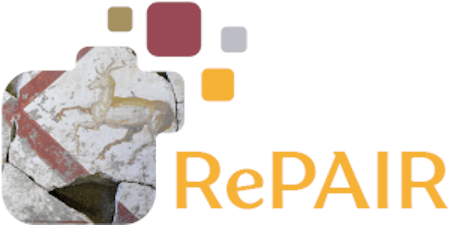THE RePAIR PROJECT COMES ONLINE ROBOTICS AND DIGITALISATION AT THE SERVICE OF ARCHAEOLOGY
The website and social media channels go online to track the progress of the project
The ‘RePAIR’ project, an acronym for Reconstructing the Past: Artificial Intelligence and Robotics meet Cultural Heritage, comes online, and courtesy of cutting-edge technology, will contribute to the reassembly of the thousands of fresco fragments from the House of the Painters at Work and the Schola Armaturarum, which are currently held in storage at the Archaeological Park of Pompeii.
The fragments, akin to small pieces of a puzzle, will be reassembled with the aid of artificial intelligence and a robotic infrastructure, equipped with mechanical arms capable of scanning the fragments, recognising them via a 3D digitalisation system, and restoring each fragment to its correct position. While the fragments are being recognised and scanned, the precision mechanical arms and hands are able to manipulate and move them, with the aid of highly advanced sensors that are capable of preventing even the slightest damage to the artefacts.
The project, which launched in September 2021 and will have a total duration of four years, has in recent months seen a series of meetings and studies, conducted by experts in the field, in order to identify the most effective logistical solutions and those critical issues that need to be resolved during the execution of the project. These days - the 15th and 16th June - have seen the meeting at the Auditorium of the Archaeological Park of Pompeii of the various partners, aimed at planning the future developments of the project, including inspections of those places where the fragments are stored.
In particular, over the course of these round table discussions, all technical matters relating to the complete scanning/acquisition of the fragments, the algorithms to be used for solving the puzzle composed of the various pieces and the logistics of the robotic system for manipulating and moving the fragile fragments were debated.
The subject of this experiment consists of the frescoes from the ceiling of the House of the Painters at Work in the Insula of the Chaste Lovers, which were damaged during the eruption of AD 79 and later reduced to fragments by the bombings of the Second World War.
A group of experts on wall paintings from the University of Lausanne, led by Professor Michel E. Fuchs, has been working on this extraordinary context since 2018, with a program of study and manual reconstruction based on the analysis of the various morphological, stylistic and technical aspects of the fragments. The launch of the new project, which will proceed alongside and in coordination with the ongoing work of the Swiss team, will therefore make it possible to compare two working methodologies and their respective results.
The second case study focuses on fragments of the frescoes from the Schola Armaturarum, which resulted from the collapse of the building in 2010 and which as yet have not been fully put back in place.
These are two iconic examples of great frescoes of world cultural heritage which are in a fragmentary state and are currently stored in the warehouses of the Archaeological Park of Pompeii.
Alongside the Archaeological Park of Pompeii, the partners of the 'RePAIR' project are: The Ca’ Foscari University of Venice (co-ordinating body), the Ben-Gurion University of the Negev of Israel, the IIT - Italian Institute of Technology, the Associacao do Instituto Superior Tecnico Para a Investigacao e Desenvolvimento of Portugal, the Rheinische Friedrich Wilhelms Universitat of Bonn in Germany and the Ministry of Culture. The project has received funding from the Horizon 2020 research and innovation program of the European Union, under Grant Agreement no. 964854.
It represents an interdisciplinary contribution of scientific and research institutes which operate in the field of computer vision, robotics and artificial intelligence, which complements the research and study of Archaeology and Conservation of Cultural Heritage.
The project website www.repairproject.eu is now online, and will, together with the dedicated social media channels (Facebook, Twitter, Instagram and YouTube), allow not only scholars and experts, but also the merely curious, to follow the progress of the various phases of activity.
In order to identify the project, a logo has been created with its own visual identity, the concept of which stems from the use of a fresco fragment that dematerialises until it transforms into pixels represented by geometric shapes, alongside the project name. The creativity of the logo expresses the union between the ancient and new technologies.


